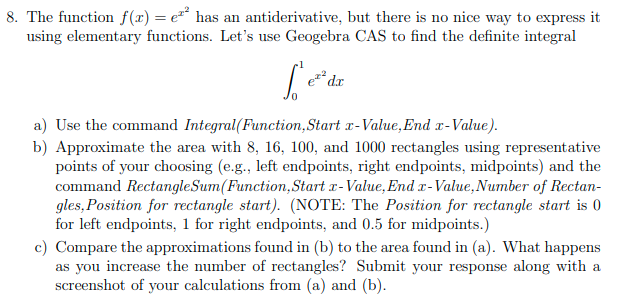8. The function f(x) = e² has an antiderivative, but there is no nice way to express it using elementary functions. Let's use Geogebra CAS to find the definite integral a) Use the command Integral(Function,Start x-Value,End r-Value). b) Approximate the area with 8, 16, 100, and 1000 rectangles using representative points of your choosing (e.g., left endpoints, right endpoints, midpoints) and the command RectangleSum(Function,Start x-Value, End r-Value,Number of Rectan- gles, Position for rectangle start). (NOTE: The Position for rectangle start is 0 for left endpoints, 1 for right endpoints, and 0.5 for midpoints.) c) Compare the approximations found in (b) to the area found in (a). What happens as you increase the number of rectangles? Submit your response along with a screenshot of your calculations from (a) and (b).
8. The function f(x) = e² has an antiderivative, but there is no nice way to express it using elementary functions. Let's use Geogebra CAS to find the definite integral a) Use the command Integral(Function,Start x-Value,End r-Value). b) Approximate the area with 8, 16, 100, and 1000 rectangles using representative points of your choosing (e.g., left endpoints, right endpoints, midpoints) and the command RectangleSum(Function,Start x-Value, End r-Value,Number of Rectan- gles, Position for rectangle start). (NOTE: The Position for rectangle start is 0 for left endpoints, 1 for right endpoints, and 0.5 for midpoints.) c) Compare the approximations found in (b) to the area found in (a). What happens as you increase the number of rectangles? Submit your response along with a screenshot of your calculations from (a) and (b).
Functions and Change: A Modeling Approach to College Algebra (MindTap Course List)
6th Edition
ISBN:9781337111348
Author:Bruce Crauder, Benny Evans, Alan Noell
Publisher:Bruce Crauder, Benny Evans, Alan Noell
ChapterA: Appendix
SectionA.2: Geometric Constructions
Problem 10P: A soda can has a volume of 25 cubic inches. Let x denote its radius and h its height, both in...
Related questions
Question
8* I need help with a calculus homework question

Transcribed Image Text:8. The function f(x) = e²* has an antiderivative, but there is no nice way to express it
using elementary functions. Let's use Geogebra CAS to find the definite integral
* d.r
a) Use the command Integral(Function,Start x-Value,End x-Value).
b) Approximate the area with 8, 16, 100, and 1000 rectangles using representative
points of your choosing (e.g., left endpoints, right endpoints, midpoints) and the
command RectangleSum(Function,Start x- Value, End x-Value,Number of Rectan-
gles, Position for rectangle start). (NOTE: The Position for rectangle start is 0
for left endpoints, 1 for right endpoints, and 0.5 for midpoints.)
c) Compare the approximations found in (b) to the area found in (a). What happens
as you increase the number of rectangles? Submit your response along with a
screenshot of your calculations from (a) and (b).
Expert Solution
This question has been solved!
Explore an expertly crafted, step-by-step solution for a thorough understanding of key concepts.
Step by step
Solved in 4 steps with 5 images

Recommended textbooks for you

Functions and Change: A Modeling Approach to Coll…
Algebra
ISBN:
9781337111348
Author:
Bruce Crauder, Benny Evans, Alan Noell
Publisher:
Cengage Learning

Functions and Change: A Modeling Approach to Coll…
Algebra
ISBN:
9781337111348
Author:
Bruce Crauder, Benny Evans, Alan Noell
Publisher:
Cengage Learning